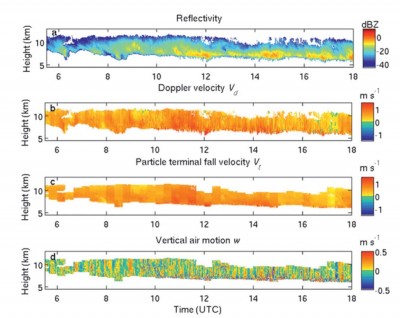
The SGP and TWP (Manus) Ice Cloud Vertical Velocities data set includes daily observations of high-cloud dynamics at the two ARM sites. The files include variables at three time resolutions: 10 seconds, 20 minutes, and 1 hour. Profiles of radar reflectivity factor, Doppler velocity, retrieved vertical air motion and reflectivity-weighted particle terminal fall velocity are given at the same time resolution. Lower level clouds are removed; however, a multilayer flag is included. In addition to these variables, cloud bases, tops, and thicknesses are included at 20-minute and 1-hour resolution.
Doppler radar velocity measurements allow for observation of ice-cloud dynamics in the presence and absence of gravity waves. The vertical air motion is used to detect gravity waves in persistent high clouds (>2-hour longevity) via wavelet analysis. High clouds are found to be less turbulent when gravity waves are observed. For these long-lived clouds, turbulence is determined via the fast Fourier transform algorithm; turbulent energy fraction and turbulent kinetic energy dissipation rate are included in the files.
A description of the Doppler-velocity decomposition technique used in this data product is given in Kalesse H, P Kollias, 2013, Climatology of High Cloud Dynamics Using Profiling ARM Doppler Radar Observations, Journal of Climate 26, 6340–6359.
For more information and access to the data, log in to the ARM Data Archive. (Go here to request an account.)
This work was supported by the U.S. Department of Energy’s Office of Science, through the Biological and Environmental Research program as part of the Atmospheric System Research program.

